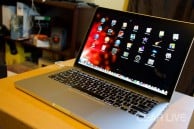Find Our Latest Video Reviews on YouTube!
If you want to stay on top of all of our video reviews of the latest tech, be sure to check out and subscribe to the Gear Live YouTube channel, hosted by Andru Edwards! It’s free!
Thursday March 24, 2011 2:22 pm
Nvidia GeForce GTX 590 review

The months-long jockeying for position between AMD and Nvidia has led to this moment: Who has the faster flagship video card? Nvidia held the crown for a long while thanks to its powerful and polished GTX 580, still the best single-processor card on the market. But when AMD released its dual-GPU Radeon HD 6990 earlier this month, and it delivered blistering benchmark results along with a sky-high $699 list price and an ultra-noisy fan, it looked like AMD might own the top tier this generation. Now that Nvidia has released its own dual-GPU card, the Nvidia GeForce GTX 590 (also $699), we definitively know the answer: AMD just wins the performance crown. Nvidia's card has some solid reasons to recommend it—much better noise characteristics, it will fit in a (slightly) wider variety of cases—but for this much money you probably want the fastest card there is. And the GTX 590, in spite of its virtues, is not quite it.
The GTX 590 is, however, packed with power. You'd expect that from any two-GPU card in general—the last one Nvidia released was the GTX 295, in early 2009—and especially from one that essentially fuses two powerful GF110 GPUs (the kind used in the GTX 580). It sports a total of 1,024 CUDA processing cores, 128 texture units, 96 ROP units, and 32 tessellation engines for making the most of one of the most sought-after DirectX 11 (DX11) features. The card's graphics clock runs at 607 MHz, its processor clock at 1,215 MHz, and its memory clock at 3,414 MHz. It's loaded with 3,072MB of GDDR5 memory for the frame buffer, which operates over a 384-bit memory interface.
In addition to the other Fermi innovations that were introduced last generation on the GTX 480, the GTX 590 also sports design changes implemented for the 500 series. These include vapor chamber cooling (one chamber per GPU), power management features to protect the card from undue throttling in stress-test apps, and a mix of transistors that result in better power efficiency. All the usual Nvidia technologies are supported: CUDA parallel processing, PhysX physics processing (though the GTX 590 has the advantage of being able to devote one GPU strictly to PhysX, which is a nice touch), and 3D Vision for stereoscopic 3D gaming.
As with any high-performance card, there might be some steep barriers to entry aside from the price. Because the GTX 590 has a TDP of 365 watts, you'll need a beefy power supply to handle it—Nvidia recommends at least 700 watts, and it will need to have at least two free eight-pin power connectors. (Assuming you have a power supply that can pull at least 1,100 watts, and enough extra dough in your bank account, you have the option of linking to GTX 590 cards in a Quad SLI configuration for even more insane performance.)
Predictably, the GTX 590 blocks a second expansion slot due to the size of its heat sink, but one welcome surprise is its length: At just 11.5 inches, the GTX 590 is designed to fit in a wider variety of cases than either AMD's 6990 or its previous performance champ, the ATI Radeon HD 5970, both of which measure 12.5 inches in length. It also has an unusual collection of output connectors: three dual-link DVI and one Mini DisplayPort. This makes it easy to connect up to three common monitors at a time (for use with Nvidia Surround display-spanning technology), without needing to shell out extra for adapters as you may have to with the 6990 (which technically supports five monitors, via one DVI and four Mini DisplayPort jacks).
Performance
The real question that matters with the GTX 590, however, is its performance. And there's no getting around the fact that the GTX 590's is outstanding. What it's not, however, is consistently better than that of the 6990.
In only two of our DX11 gaming tests did the GTX 590 outperform the 6990. In Lost Planet 2, the GTX 590 earned 68.9 fps at 1,920 by 1,200 (compared to 51.5 fps and 53.4 fps for the 6990) and 51.7 at 2,560 by 1,600 (compared to 42 fps and 43.6 fps). In H.A.W.X. 2, the GTX 590 nabbed 198 frames per second (fps) at 1,920 by 1,200 and 139 fps at 2,560 by 1,600, compared to 161 fps and 116 fps at 1,920 by 1,200 (at the base clock) and 162 fps and 117 fps (when the 6990's overclocking switch was enabled)—but with the frame rates already so high for both cards, Nvidia's victories mean a little less. (The GTX 590 also just barely edged out the 6990 in our 1,920-by-1,200 Heaven Benchmark test, earning 48.8 fps to the overclocked 6990's 48.5 fps.)
Otherwise, the 6990 came out on top again and again. The GTX 590 earned 8,629 in 3DMark 11 on the Performance preset; the 6990 earned 8,901 and 9,175 depending on the overclocking switch; at the Extreme preset, it was 2,993 versus 3,285 and 3,419. In Aliens vs. Predator, the GTX 590's 67 fps at 1,920 by 1,200 was outshone by the 6990 earning 77.2 fps and 79.9 fps; at 2,560 by 1,600, the GTX 590's 43.5 fps didn't quite compare with the 48.4 fps and 50.5 fps of the 6990. The GTX 590 came in considerably under in Just Cause 2, with results of 42.8 fps and 33.9 fps at both resolutions; the 6990 earned 68.42 fps and 70.21 fps (1,920 by 1,200) and 48.72 fps and 50.58 fps (2,560 by 1,600). Metro 2033 was closer: 47.67 fps and 29.67 fps for Nvidia, and 54.33 and 52.67 (1,920 by 1,200) and 35 and 35.33 (2,560 by 1,600) for the 6990. S.T.A.L.K.E.R.: Call of Pripyat showed an even narrower margin, with only the overclocked 6990 (94.5 fps) beating the GTX 590 (92.2 fps) at 1,920 by 1,200 (at base speed, the 6990 managed 91.2 fps), but both clock speeds besting the GTX 590 at 2,560 by 1,600 (61.45 and 64.25 versus 59.15).
As for power usage, Nvidia has made a lot of strides—but apparently not quite enough to even score a definitive win there. While idling in our test-bed desktop, the 6990 uses 148-149 watts (the overclock switch makes a negligible difference), and the GTX 590 160 watts. Under load, in a variation on our Metro 2033 benchmark and measured with an Extech Datalogger, things got slightly more interesting. At its base clock speed, the 6990-equipped system was the winner, at 413 watts. But when the 6990's overclocking switch was enabled, its system used functionally the same amount of power as the GTX 590's: about 446 watts.
Where the GTX 590 demonstrably shines in comparison to AMD's 6990 is in terms of noise. We found AMD's card loud to the point of distraction, especially when playing games at high resolutions and detail settings. We can't lie and say we couldn't hear the GTX 590—it was certainly detectable when it was working most heavily, even in a closed case. But the sound it generated always struck us as within acceptable limits in a way the 6990's isn't.
The battle between the Nvidia GeForce GTX 590 and AMD Radeon HD 6990 is by far the most interesting we've seen in this generation of video cards. Though both are outrageously (if understandably) expensive, each offers unique reasons you may want to choose it. We love Nvidia's dedication to keeping noise levels down (the typical gaming PCs we build around here are loud enough as it is!), and prefer the three-DVI-port solution for multimonitor to AMD's adapter-heavy approach. All things considered, however, for $700, performance is where it's at. The 6990, usually both with and without its overclocking switch activated, turns in more impressive results a little more often—so we have to give it just the slightest edge if a single-slot, dual-GPU card is what you're shopping for. You can't go wrong with the Nvidia GeForce GTX 590—but unless noise is your chief concern, you can go just a bit righter with the AMD Radeon HD 6990.
This article, written by Matthew Murray, originally appeared on PCMag.com and is republished on Gear Live with the permission of Ziff Davis, Inc.











